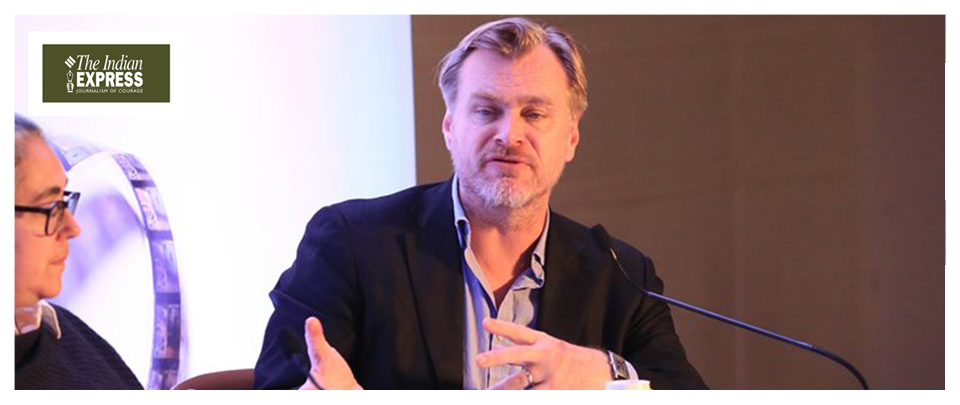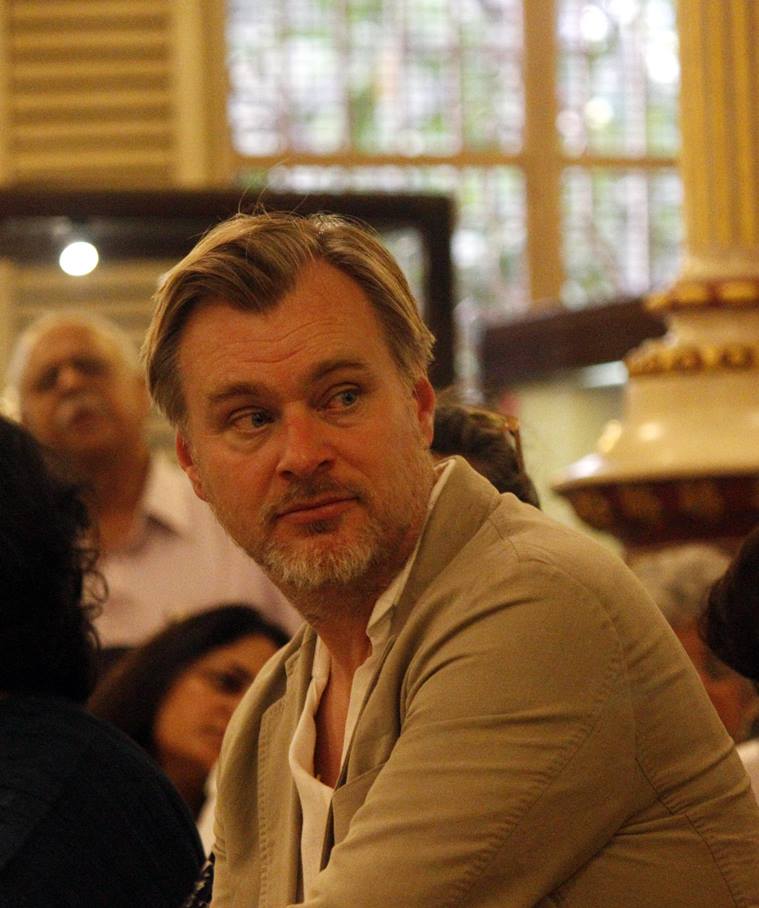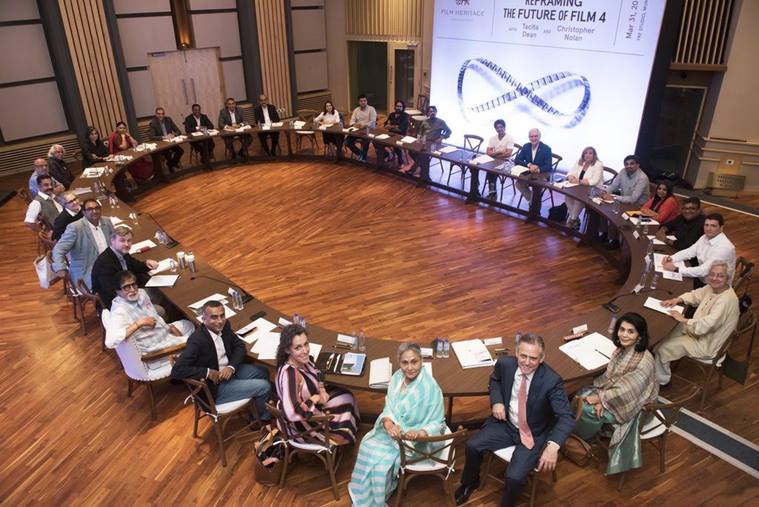Inside Christopher Nolan’s roundtable with the A-listers of Indian cinema
The Indian Express 08.04.2018 by Shubhra Gupta
Listening in at a roundtable with Christopher Nolan, where he pitches celluloid as the future of film to the A-listers of Indian cinema.
It is one of the most enduring cliffhangers in the movies, leading to endless head-scratching and obsessive speculation amongst film-goers around the world. Did that famous spinning top in Inception fall over? Or not? Christopher Nolan must have been confronted by the question countless times, but he displays only affability when I ask him about that climactic sequence from his mind-bending 2010 blockbuster.
“The character (in the film) doesn’t care anymore,†says Nolan, 48, “he’s moved past it. So, I must have too.†That he has, amassing the kind of enviable filmography (The Dark Knight, Interstellar, Dunkirk) and success which is his passport to notoriously tight-fisted Hollywood studio bosses: he has a free hand, as much as anyone can, to make the films he wants to, and more importantly, the way he wants to. On celluloid, which allows for breathtaking wide frames, immense depth, and a feeling of being right here, right now, as real as real can be, at second remove.
We are in the foyer of the Yash Raj studios in Mumbai, where, in a few minutes, Nolan and celebrated visual artist Tacita Dean are about to address a roundtable of some of the most influential stakeholders in Indian cinema, on the merits of re-embracing celluloid, and how imperative that is in the pursuit of saving film for posterity.
The first of these “roundtables†was held in Los Angeles in 2015, followed by similar events in London and Mexico. This one in Mumbai is in collaboration with the Film Heritage Foundation, founded by Shivendra Dungarpur, whose aim is to protect and preserve Indian cinema’s rich cinema heritage.
Present, among others, are Amitabh and Jaya Bachchan, staunch supporters of Dungarpur’s cause. As are Shyam Benegal, Kumar Shahani, Adoor Gopalakrishnan, Kamal Haasan, Shah Rukh Khan, producer Siddharth Roy Kapur, Sai Prasad of the famous Prasad Labs, filmmaker Ashim Ahluwalia, festival director and curator Bina Paul, as well as Kodak CEO Jeff Clarke, who is happy to debunk the dictum that celluloid is dead, long live digital.
After listening to Dean and Nolan’s introductory remarks, which emphasize co-existence, not confrontation between celluloid and digital, and the importance of having the freedom to choose, Amitabh Bachchan harks back to the days when performers like him would say “cut, cut, cut†if they fumbled. Those time-honored words are no longer required (as his young directors tell him kindly) because, hey, digital can erase all glitches, no worries.
There is no doubt that the spread of digital technology has, in many ways, freed up the process of filmmaking, and made it easier, less expensive, more democratic. When such auteurs as Steven Soderbergh can use their cellphone to shoot a film (his latest Unsane was shown at the Berlin Film Festival in February), well, what’s to stop you and me from doing so?
And some films, the way they are conceptualized and shot, cannot be made any other way. Dibakar Banerjee’s groundbreaking Love Sex aur Dhokha (which released, coincidentally, the same year as Inception) needed the jerkily-constructed reality bites of the digital cameras, to give us a never before seen slices of contemporary Indian life.
The digital ecosystem is now so strong that it is difficult to find cameras, stock and other tools for those who wish to work with celluloid, as Ahluwalia pointed out; and it is becoming almost impossible to find theatres which have the capacity to screen films on celluloid.
Benegal pointed out that there is hardly any infrastructure left to shoot on film. Does any latter-day projectionist even remember what it was like to change reels, thread film through sprockets? Do any of us recall that distinctive whirr of projectors? And the biggest question: is this romantic hankering after celluloid strictly nostalgia, restricted only to purists, leading to the making of films which will be dismissed as niche or artisanal?
It is a heady conversation, even for the skeptics, who cite the practical convenience of shooting on digital. But equally, it is hard to overlook just how plangent celluloid can be, how much more it can make you feel: great cinema comes only when emotion trumps technology. Kumar Shahani, whose Maya Darpan (1972) still gleams, talks of how the film is close to divinity, and how celluloid doesn’t “command†you to look, the way digital does; it “persuadesâ€.
But how do you take this debate out of this high-powered room and its high-profile participants to the punters who buy the ticket? Why should she care if what she’s watching has been shot on celluloid or digital? If the message is the product, who cares about the medium?
Both Nolan and Dean, who describes working with celluloid as a play of “light and chemistry and poetryâ€, believe that this is reductive thinking, that it is not that hard to recreate the necessary infrastructure (the first shift to digital projection happened in India only in 2003) and that passion and conviction is the first step in that direction.
“So much of film history is photochemical,†says Nolan. The only way to “futureproof†film is to use celluloid, which has a sense of permanence even in its imperfections; digital is much more fragile and prone to breaking down into unrecognizable pixels.
Evangelists have to work hard, and put their mouth where sometimes there is no money: as the discussion comes to a close, Amitabh Bachchan offers his services to help spread the good word, and both Santosh Sivan who creates magical images, and cinematographer Sudeep Chatterjee, whose last film was Sanjay Leela Bhansali’s Padmavati say they will shoot their next on celluloid.
At lunch, I ask Nolan whether he has seen any Indian films. He has just watched Satyajit Ray’s Pather Panchali and feels it is one the best films ever made. “It is about a family and its difficulties,†he says. “I can’t think of anything more universal. And it may have been made in 1955, but it feels like it was shot yesterday.â€
Now that is true timelessness.


